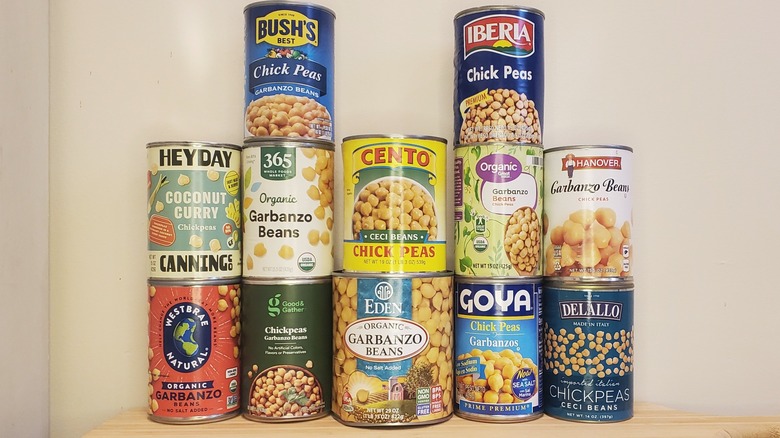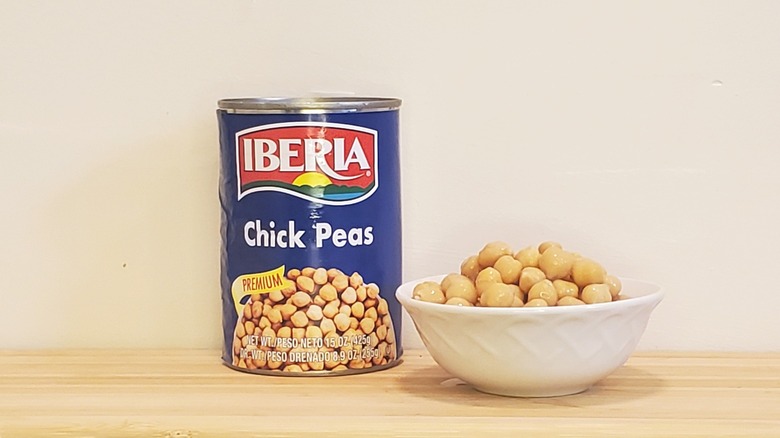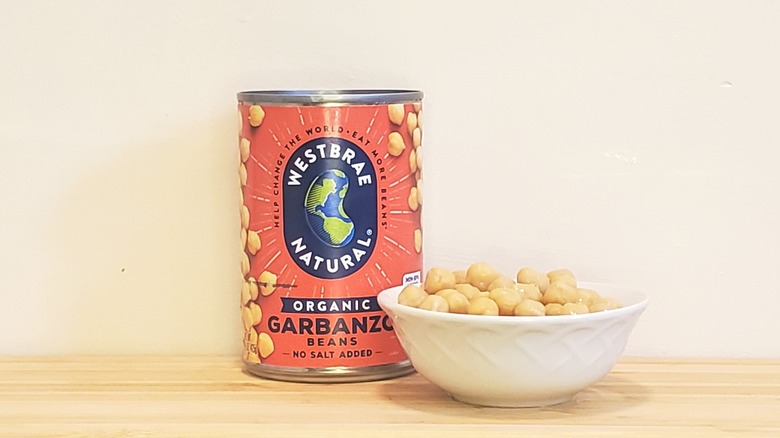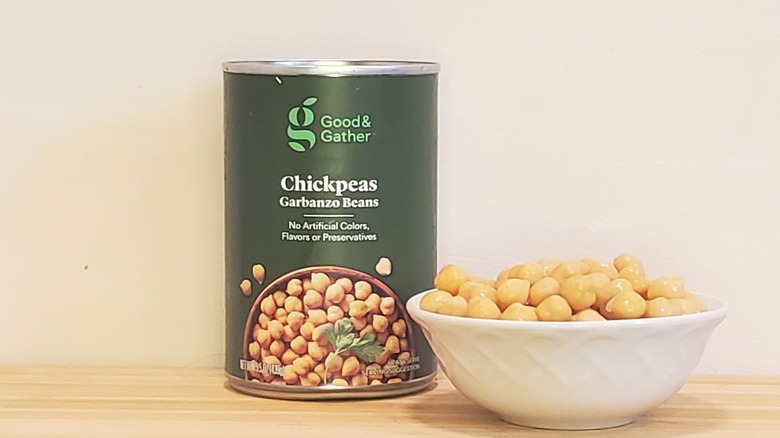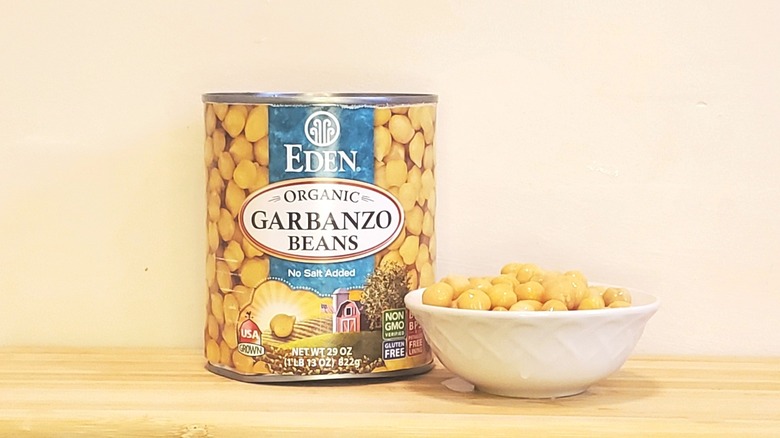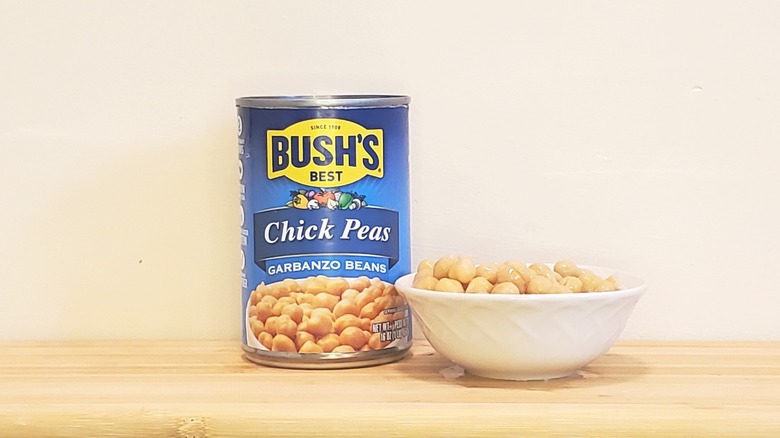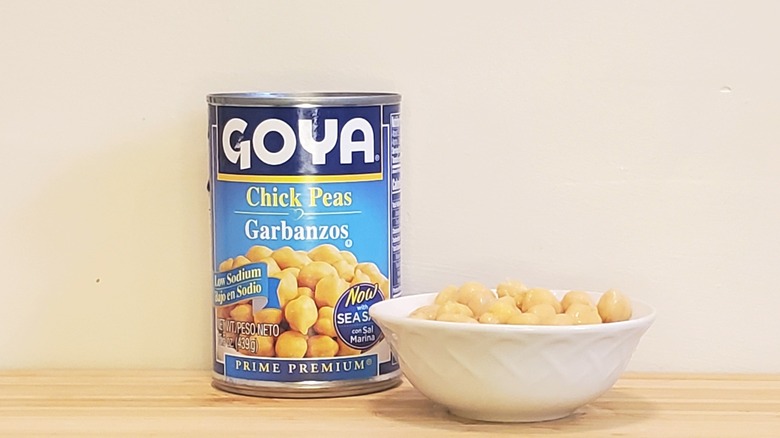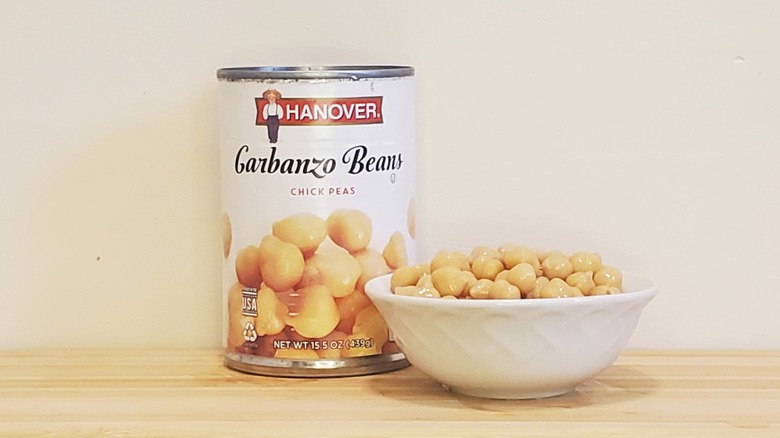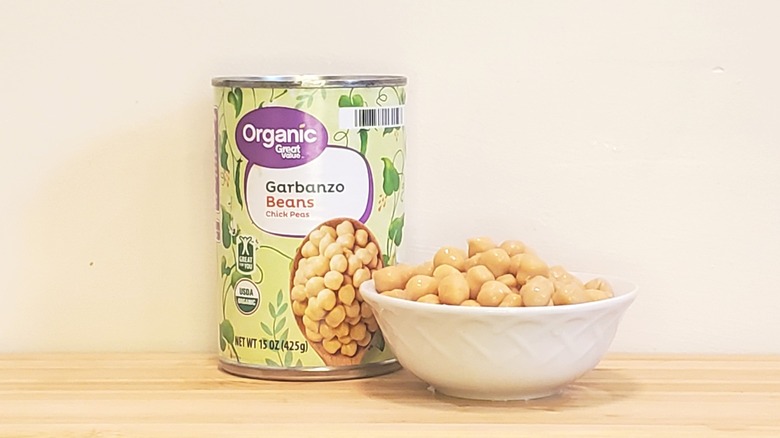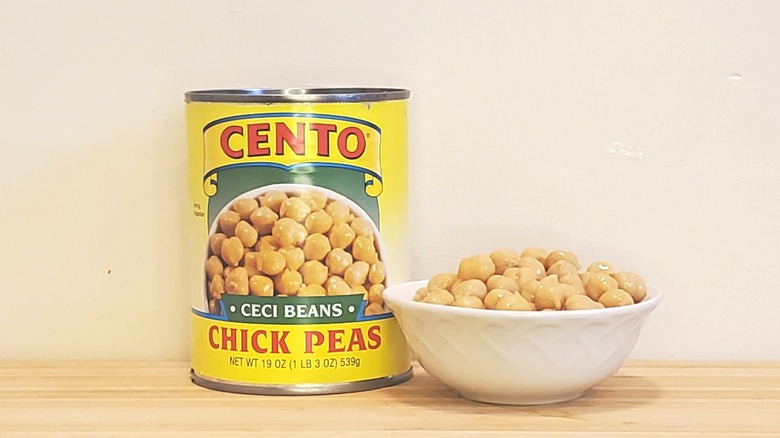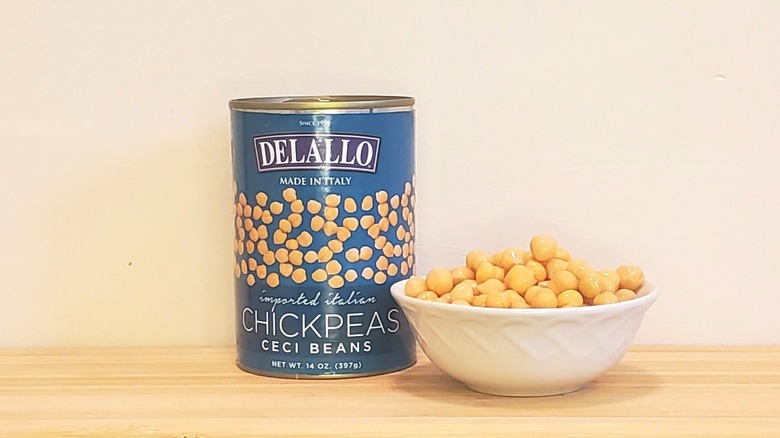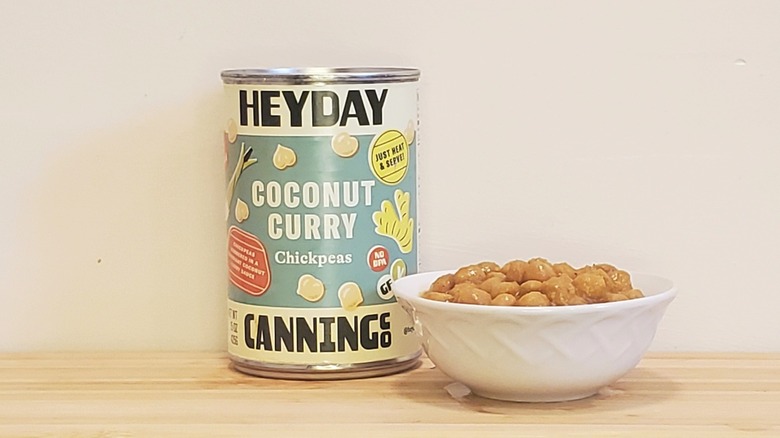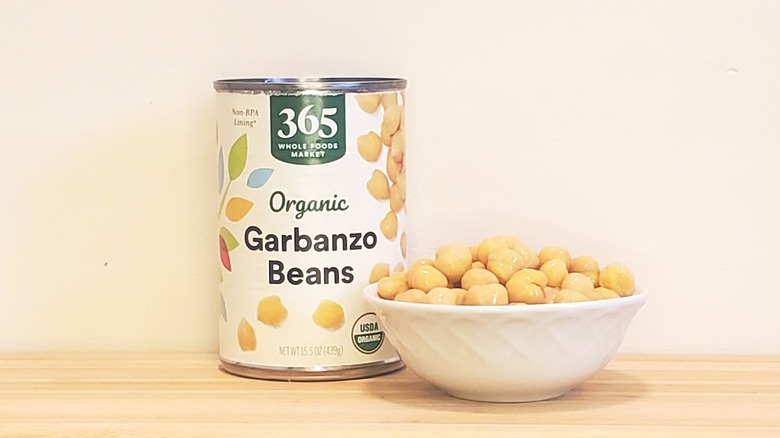12 Canned Chickpea Brands, Ranked
Chickpeas are adaptable for many cuisines, such as Mediterranean or Middle Eastern cooking styles. These legumes are nutrient dense; 1 cup contains upwards of 14.5 grams of complete protein. "Complete" means the food contains all the essential amino acids that are necessary to help our cells — and bodies — perform well. All that protein makes it a great option for vegans and vegetarians. Chickpeas are also rich in fiber, so they aid in proper gut health and keep you feeling full for longer. This powerful bean also contains calcium, iron, potassium, magnesium, and vitamin A, E, and C. Chickpeas are also notable in what they lack: cholesterol and high sodium. Though, some brands will add extra salt to their chickpeas.
As a type of bean, dried chickpeas require additional preparation before they can be eaten. Fortunately, canned chickpeas bypass all that labor. They are ready-to-eat, and do not require overnight soaking or any additional preparation. Some of the cans on this list even featured flip-top lids for easy opening. The canned version are suspended in liquid called aquafaba that can be used for additional culinary purposes.
Chickpeas can be used as a main entrée, a side dish, or a nutritious snack, especially when roasted. I tested several different canned chickpea brands and ranked them according to taste, texture, and how they roasted, as well as the flexibility of the liquid they come in, aquafaba, which can be used in cooking. Prices may vary based on location.
12. Iberia
Iberia is a food and beverage brand that gears its products towards U.S. Hispanic and Caribbean markets. This brand has been in business since 1930 and continues to be widely available in stores across the country.
Iberia's chickpeas were on the smaller side and were the toughest on the list. Concerning the taste, they were too sweet and had an odd flavor. This is the first of several brands that contain disodium EDTA to keep the color quality of the bean. This chemical is currently deemed safe by the Food and Drug Administration, but animal studies have correlations between worsening of gut health and conditions like colitis.
These chickpeas were difficult to peel without smashing the bean altogether. The roasted version came out dry and was not at all crunchy, while the aquafaba tasted like chickpeas but it was a bit too thin to be of use. In addition to these issues, these chickpeas were the least tasty of all the brands so I placed it at the lowest ranking.
11. Westbrae Natural
Westbrae Natural does not feature a lot of information about its products on its website. But it does want you to know its efforts in sustainability. The company claims to work with organizations that fight climate change and ensure food security. It's no surprise, then, that its chickpeas are certified USDA organic and Non-GMO Project verified. Its cans also feature a non-BPA lining. BPA, aka bisphenol A, is an industrial chemical found in plastics. Although the Food and Drug Administration has suggested that trace amounts of the chemical are safe, other research has suggested that it may have detrimental effects on human health.
While the brand may tout its labels, its raw product was very bland. Additionally, the aquafaba was too thin to be useful and had a strong chickpea flavor. The legumes were easy to peel after roasting, but the peels stuck to my fingers and made it difficult to work with. The roasted chickpeas were extremely dry and not crunchy, and their strong chickpea flavor made them unpleasant to eat.
On the positive side, Westbrae Natural Chickpeas only contain 10 milligrams of sodium. Each ½ cup contains 120 calories and 6 grams of protein, but it was more costly than other brands, which earned it a low spot on this ranking. While the promise of high-quality chickpeas was appealing, the taste was flat and much too dry. At a higher price point, Westbrae chickpeas were disappointing and could not be ranked higher.
10. Good & Gather
Target's in-house brand, Good & Gather, offers the most cost-effective beans on the list. The can came with a flip lip that was the easiest to open out of all the products I sampled. The chickpeas themselves were disappointingly small, which made them hard to peel for roasting. The aquafaba was bland and watery, too. These little legumes were hard, but they did have a tasty, mild flavor. When I roasted these chickpeas, I noticed that despite their size, many came out mushy rather than crunchy and had less flavor than when I tried them from the can.
Good & Gather chickpeas have 120 calories in a ½ cup serving, which contains 7 grams of protein and 140 milligrams of sodium. The ingredients are simple — just chickpeas, water, and salt. I was pleased at the price, but roasted chickpeas should not turn out so poorly. Size, difficulty in cooking, and less-than-exciting flavor placed this brand in the bottom three.
9. Eden Foods
Eden is an organic brand known for its extensive line of beans. The chickpea can features a slew of labels: non-GMO, organic, non-BPA, non-BPS, and phthalate-free.
What is most interesting about this brand is that Eden's chickpeas were the only brand I reviewed that contains kombu seaweed. This is the one ingredient to look for when buying canned chickpeas for aquafaba because it has stabilizing properties. You won't even need cream of tartar to whip it into a meringue. Be aware that discerning noses may detect the scent of seaweed.
The chickpeas from this brand were a good size. They were neither mushy nor too firm. However, the kombu gave the legume a slightly sweet taste, which is curious given that these had the lowest sugar content of all the brands I sampled. This may have prevented the chickpea flavor from coming through. Eden's were the easiest chickpeas to peel. Once roasted, they were very crunchy. Unfortunately, the flavor was still rather bland and a bit too sweet.
This is another low-salt brand, with only 50 milligrams of sodium per serving. In addition to iron, calcium, and potassium, this brand featured small amounts of magnesium and zinc. However, it was twice the price of most of the other beans on this list. This brand had a great deal of nutritious pluses but sweetly-flavored chickpeas do not work well for savory dishes. Between that and the high price point, I could not rank this brand any higher.
8. Bush's Best
Next up is the brand synonymous with beans — particularly the baked variety: Bush's Best. Since this brand only makes beans, it should meet a high bar for quality. When consumed raw, these legumes were tough and a little too salty. That said, they had a nice flavor. The aquafaba was also salty and too thin. This was also another brand that contained disodium EDTA.
The chickpeas were not too difficult to peel. The roasting process allowed the beans to shine with a light crunch, delicious flavor, and perfect texture. Despite the large size of the bean, the batch of roasted chickpeas didn't come out too dry.
Bush's Best chickpeas contain 120 calories and 6 grams of protein per ½ cup serving. As my taste-test suggested, the sodium levels for this can were quite high at around 480 milligrams per serving. While the flavor, both raw and roasted, was good, I was not happy with the sodium levels nor the poor quality aquafaba, so I placed this mid-range. If you can tolerate EDTA, these are a good choice for roasting.
7. Goya
Goya is well-known for its premium Latin food options. Although chickpeas are not as common in this type of cuisine as others, Goya is a well-known and widely available canned chickpea brand.
This can featured a flip top that immediately got stuck and was difficult to open. But once I got it opened, I noticed that the beans had a nice texture. The flavor came off as a little sweet but was overall solid. The aquafaba was also tasty — but very thin. Goya chickpeas were some of the easiest to peel on this list. Roasting the toned down the taste, but the beans came out mushy and dry, which is why I wouldn't recommend it for roasting.
These beans contain 6 grams of protein, 340 milligrams of sodium, and 120 calories per ½ cup. I'd recommend adding flavor to these canned chickpeas with another ingredient, like lemon juice, and eating them raw on top of a salad. I knocked this one down a few points for the sweetness in flavor as well as the poor roasting quality.
6. Hanover
This nationwide brand, which hails from Hanover, Pennsylvania, claims to combine its farming traditions with modern sustainable practices to produce quality food. So how do these chickpeas taste?
The flavor was good, but it was a bit too salty, as was the aquafaba. That's not surprising with the 350 milligrams of sodium per serving. The chickpeas themselves were rather small, but that did not make them too difficult to peel. Once roasted, Hanover chickpeas were just right. The beans came out nice and crunchy, with a good chickpea flavor that was not too overpowering. However, Hanover's chickpeas do contain EDTA, as well as 120 calories and 7 grams of protein per ½ cup serving.
The reasonable price and mild but delicious flavor make these chickpeas a great choice for all of your needs. I ranked these in the mid-range because they were so high in sodium and saltier than I would have liked. All that salt could negatively impact your recipes.
5. Great Value
I chose the organic version of Walmart's in-house brand, Great Value, because it was price-comparable to the conventionally grown product. Overall, Great Value offers organic products at a decent price. However, this brand is sometimes hit or miss when it comes to taste. The chickpeas had a passable flavor, with a nice texture — but it wasn't anything extraordinary. The aquafaba was both thick and bland, making it an ideal choice for recipes, like using aquafaba in cocktails.
Peeling the skin off the beans was a breeze. Unfortunately, though, these chickpeas were not as tasty when they were roasted. They came out rather dry and flavorless with barely any crunch. I'd recommend selecting another brand for roasting.
Overall, the Great Value chickpeas live up to its name but dropped to the No. 5 spot due to points deducted for the less-than-ideal roasting result. What I did like about this brand is that it only contained organic chickpeas, water, sea salt. I also liked the flip lid. With 6 grams of protein and only 110 calories in a ½ cup serving, there are plenty of uses for these canned chickpeas that capitalize on their neutral flavor.
4. Cento
Cento offers authentic Italian ingredients at a reasonable price. Many Italian recipes utilize this utilitarian bean, including pasta e ceci: pasta and chickpeas. Overall, the Cento chickpeas did not have a strong flavor, but the texture was absolutely perfect. These small beans were silky smooth on the tongue. While the aquafaba was thick and flavorful, it was a little too salty.
Cento's chickpeas peeled easily and offered a mild, yet pleasing, flavor once roasted. However, they were barely crunchy, which is why I preferred eating them raw.
These legumes contain 110 calories and 7 grams of protein in a ½ cup serving. The sodium level was rather high at 350 milligrams. The cost of the cans was also high, but I could not discern if this may have been because the chickpeas were imported from Italy. Some cans also contain disodium EDTA, although mine did not. Overall, Cento chickpeas are a great choice, but it did not make the top three due to the high sodium levels and the higher price.
3. DeLallo
DeLallo is a brand that got its start in an Italian marketplace near Pittsburgh. Today, it features Italian and Mediterranean products including chickpeas — or ceci beans, in Italian. These chickpeas are imported from Italy, which is likely why they are priced on the higher side. I ranked this can close to the top for its incredible flavor and ease of use.
The beans were small and had a middle-ground texture that was smooth in the mouth. The flavor of the beans was delicious and mild, and it translated to the thick aquafaba well. The skins came off the beans easily, but their small size made it feel like more work. While roasted, DeLallo chickpeas didn't have much crunch but they were tasty, which contributed to their position on this list. My biggest complaint about these canned chickpeas was the flip-top lid, which stuck rather easily. I thought it was going to break off before coming completely free of the can. DeLallo's Italian chickpeas contained a whopping 220 calories per ½ cup and 7 grams of protein.
What also stood out was that these chickpeas contained upwards of twice the amount of carbohydrates as other brands and the sodium level was high at 350 milligrams. It should also be noted that DeLallo also carries chickpeas produced in the U.S, which have calories and carbs closer to other brands listed here. DeLallo's imported chickpeas are a great option for Italian dishes, which is why I put it in the top three.
2. Heyday Canning Co.
If you'd like your canned beans ready-made, then Heyday Canning Co. is the brand to pick. It carries six varieties of canned beans in seasoning, including two chickpea options. It claims its beans are naturally preserved using heat alone. For this piece, I chose the coconut curry flavor, which came in at number two in this ranking.
These legumes need no preparation whatsoever; simply pop open the flip lid and you're good to go. Even cold, these beans were simply delicious. They were perfectly seasoned with a good balance of coconut and curry. The chickpea flavor also came through well. The ingredients on this can included organic or non-GMO beans, coconut milk, guar gum, raw agave syrup, corn starch, garlic, and turmeric.
The serving size is larger than ½ cup, and the calories and sodium levels reflect this — as well as the addition of coconut milk. Each 5-ounce serving contains 260 calories and 510 milligrams of sodium. Heyday's Canning Co.'s chickpeas make a perfect meal over rice as-is. Or you can add vegetables, shrimp, or chicken for an easy dinner entrée, but be sure not to stretch it too far. The only thing you can't do with these chickpeas is roast them because they will burn, which is the reason this delicious selection did not earn the coveted top spot.
1. 365 Organic
Whole Foods 365 brand features organic products at a great price. Its organic garbanzo beans were priced much lower than other premium products I sampled. These legumes are USDA-certified organic and are one of only two brands on this list made with sea salt. They're also canned with BPA-free lining.
365's chickpeas had a well-rounded flavor that was not too salty and very tasty. The mouthfeel was good, with a nice medium texture — not too tough or too mushy. There was no "off" flavor about them, landing them in the top spot of this ranking. The aquafaba was thick with a very mild chickpea flavor, making it a perfect choice for recipes that call for it.
The beans were easy to peel. Some of them roasted perfectly, while some came out a little too mushy. I recommend roasting them for at least 30 minutes for the perfect texture. The roasted chickpeas had a smooth flavor, although I did prefer this brand raw.
365's chickpeas contain 120 calories and 7 grams of protein per ½ cup. They only have 90 milligrams of sodium, which is surprising given the flavor. Between the price, flavor, and flexibility, this brand was a clear winner for the No. 1 spot. It meets all your chickpea needs — whether you're making a simple creamy hummus recipe or trying a more complex sweet-and-sour chickpeas with crispy pappadum recipe. No matter the cuisine, Whole Food 365's chickpeas have you covered.
Methodology
I purchased some of the most popular and available chickpeas brands for testing and compared them first by taste and texture of the raw chickpea. Some brands, like Trader Joe's, were excluded because the chickpeas are not available to every shopper in every region. During the first phase of the taste-test, I considered how the saltiness and other factors impacted the overall flavor. I also examined the texture to try and find a chickpea that was not too hard, but also not mushy. The best chickpeas had a silky-smooth mouthfeel that didn't lean on the dry side.
Next, I roasted all the chickpeas at 450 F for 25 minutes with extra virgin olive oil and a sprinkling of salt. Then, I examined the crunchiness and the taste. For this holistic review, I also considered how easy it was to remove the chickpea skin, as well as the size of the legume. Bigger chickpeas were better for cooking, peeling, and roasting.
I also judged the quality of the aquafaba, which is often used to make non-dairy meringue, requiring a thicker quality with a neutral flavor. I deducted points if it was too salty, too thin, or had an odd flavor. The final metric I used to rank the chickpeas was nutrition and cost. I examined the macronutrients, as well as if each product used preservatives. In addition, I factored in organic, non-GMO certification, as well as packaging materials. Organic products ranked higher if they were flavorful and cost-effective.
